Budae jjigae (Army stew) is easy to make. As long as it has kimchi and some American processed meats, it’s a budae jjigae. This budae jjigae recipe will give you a few tips for making it delicious!
What is budae jjigae?
Budae jjigae (부대찌개) is a fusion dish that incorporates American processed meats such as Spam, ham, bacon, and hot dogs into a Korean stew with kimchi. Budae is a general term for a military base in Korean, but budae jjigae is translated into “Army stew” or “Army base stew” because of its origin.
In the 1950’s, food was extremely scarce after the three-year long Korean war which ended in 1953. So, those surplus processed meats from the U.S. military bases were great sources for Koreans to supplement their food shortage. In the city of Uijeongbu (의정부), about 12 miles northeast of Seoul, where U.S. Army bases are stationed, a restaurant owner started to make a stew with those meats from the Army bases. Since then, budae jjigae has become immensely popular as a delicious comfort food all over Korea.
How to make Korean army stew
As long as it has kimchi and some processed meats, it’s a budae jjigae. You can’t go wrong with the combination of sour kimchi and fatty bacon, spam, ham, and/or hot dogs. The older the kimchi is, the better your stew will taste.
Other popular bugae jjigae ingredients include: slices of American yellow cheese, canned baked beans, instant ramyeon (or ramen) noodles, and rice cake slices.
I kept it simple in this budae jjigae recipe. To make the stew, cut the ingredients into bite size pieces, and arrange them in a medium size shallow pot. Cook after adding the broth and seasoning ingredients.
Tips for making and enjoying budae jjigae
- Use flavorful broth such as anchovy broth or good quality store-bought beef or chicken broth.
- Have extra broth so you can replenish while eating, if needed.
- Noodles absorb lots of liquid if you cook them in the stew. Pre-boil the noodles right before adding to the stew.
- Cook the stew over the portable burner at the table for more delicious experience. You can add more ingredients as the diners take some out to eat. Most ingredients in this recipe don’t take long to cook.
- Eat the noodles first while they are still nicely chewy. This will also prevent the noodles from soaking up too much liquid from the stew.
- Freeze the leftover processed meats for longer storage and more budae jjigae later.
More Korean stew recipes
Kimchi jjigae
Kimchi soondubu jjigae
Haemul jeongol (seafood hot pot)
Doenjang jjigae
Gamjatang (spicy pork bone stew)
For more Korean cooking inspirations, follow along on YouTube, Pinterest, Twitter, Facebook, and Instagram.
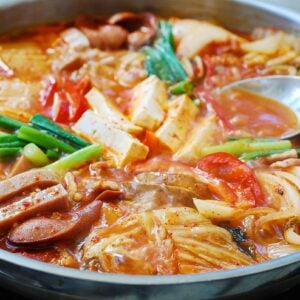
Ingredients
- 2 cups baechu (napa cabbage) kimchi
- 2 hot dogs (or sausages)
- 3 strips bacon (or about 3 ounces fatty pork),
- ⅓ can of spam (about 4 ounces)
- 4 ounces tofu, sliced (about 1/2-inch thick)
- 1/2 medium onion, thinly sliced
- 3 to 4 mushroom caps, sliced
- 2 scallions, cut into 2 inch pieces
- 1/4 red bell pepper, sliced - optional
- 4 cups anchovy broth (or beef or chicken stock) More if you want extra broth. You can also use water.
Seasoning
- 1 tablespoon gochugaru (Korean red chili pepper flakes) Use more for a spicier stew
- 1 teaspoon gochujang (Korean red chili pepper paste)
- 1 tablespoon soup soy sauce (or salt to taste)
- 1 tablespoon minced garlic
- 1 to 2 tablespoons broth or water
- black pepper to taste
Optional
- 1 package instant ramyeon noodles Pre-boil right before adding to the stew to keep them from absorbing too much liquid from the stew
Instructions
- Cook over medium high heat until the bacon is cooked through and the kimchi has softened. Add the optional ramyeon noodles and more broth or water if necessary. (The noodles soak up a lot of the liquid, so I briefly cook the ramyeon noodles in a separate pot of water before adding to the stew.)
Notes
- Use flavorful broth such as anchovy broth or good quality store-bought beef or chicken broth.
- Have extra broth so you can replenish while eating, if needed.
- Noodles absorb lots of liquid if you cook them in the stew. Pre-boil the noodles right before adding to the stew.
- Cook the stew over the portable burner at the table for more delicious experience. You can add more ingredients as the diners take some out to eat. Most ingredients in this recipe don’t take long to cook.
- Eat the noodles first while they are still nicely chewy. This will also prevent the noodles from soaking up too much liquid from the stew.
- Freeze the leftover processed meats for more budae jjigae later.


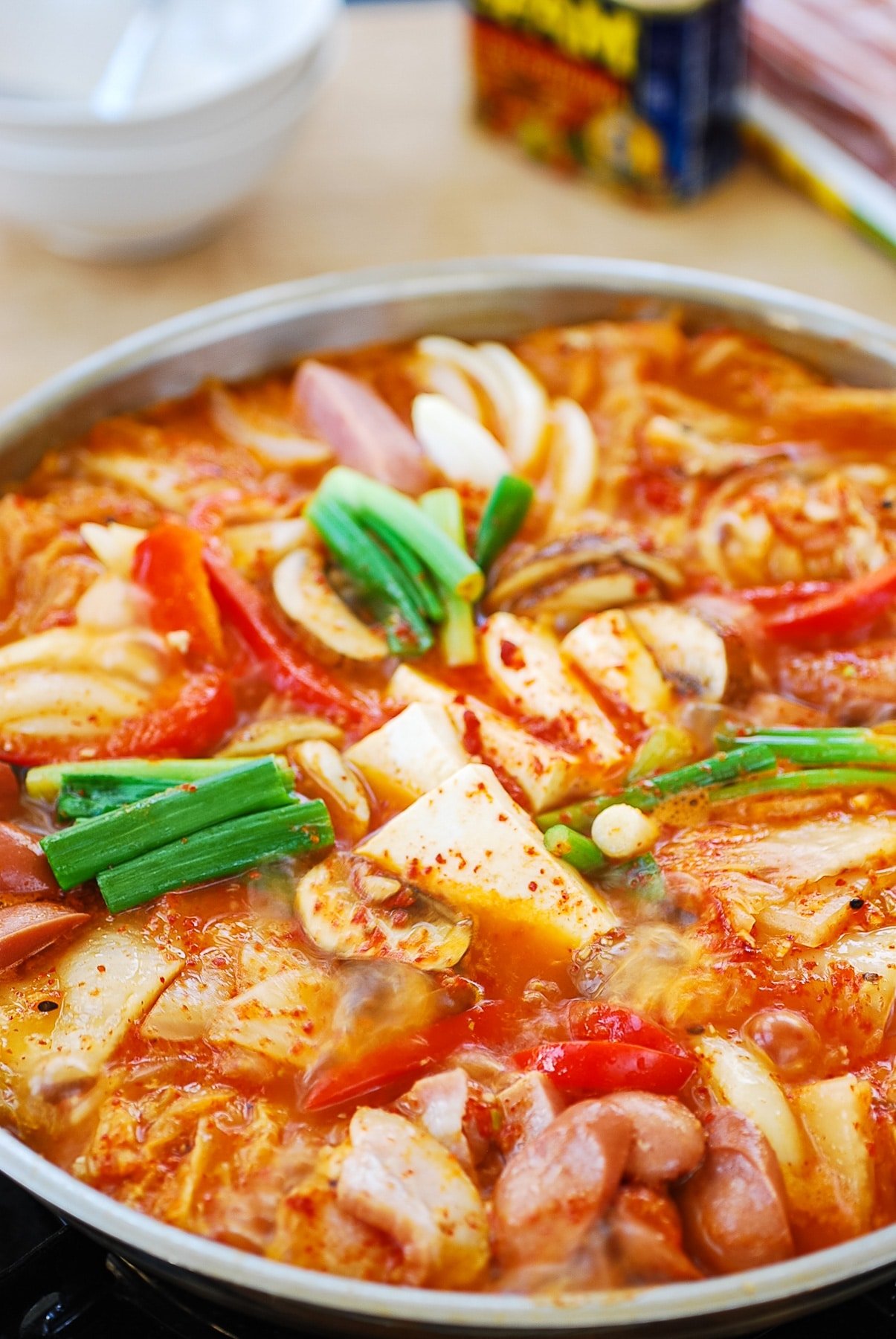

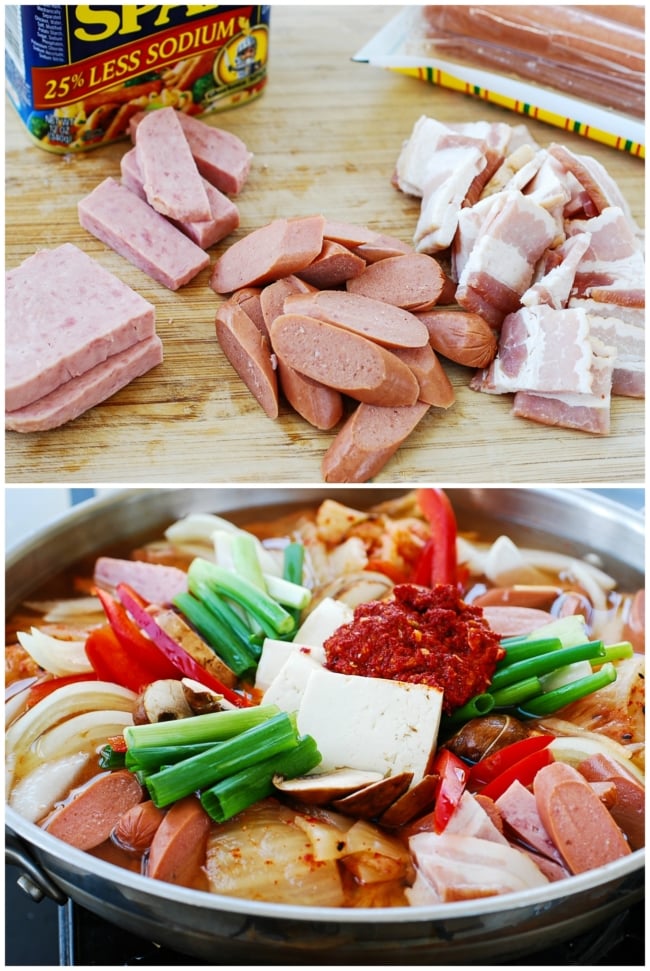
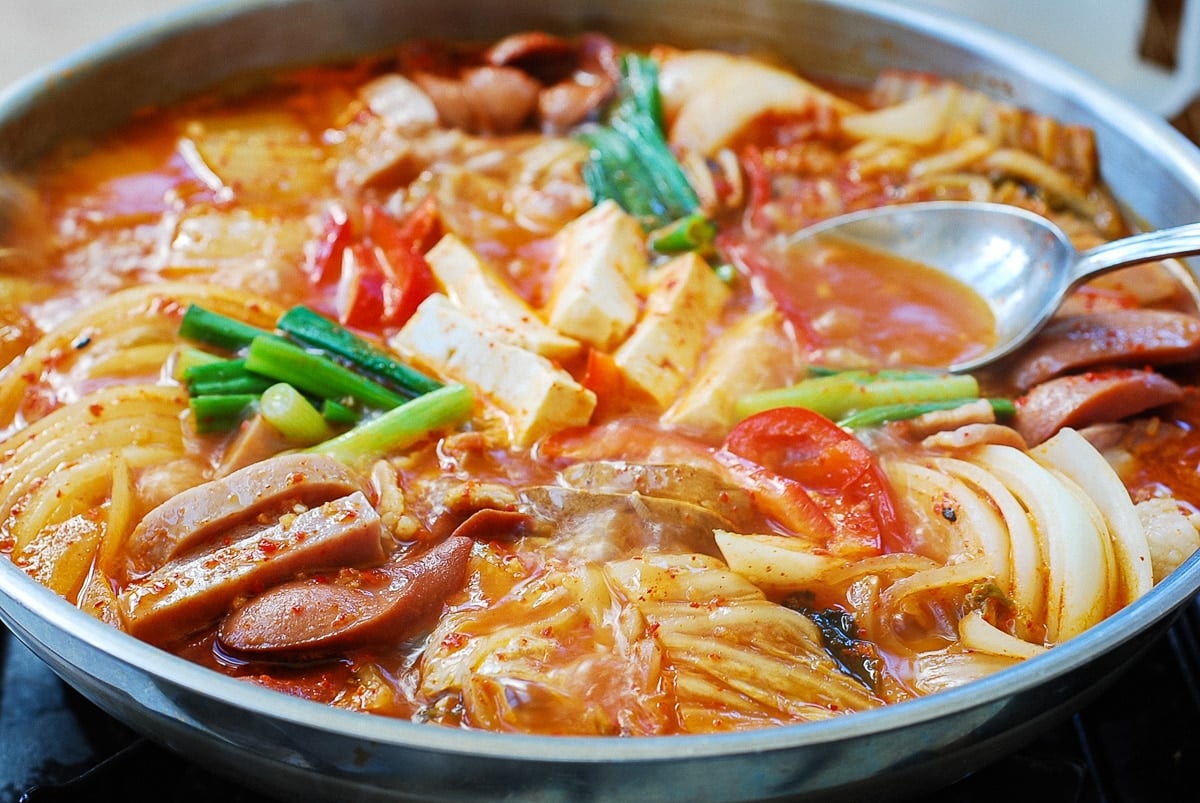
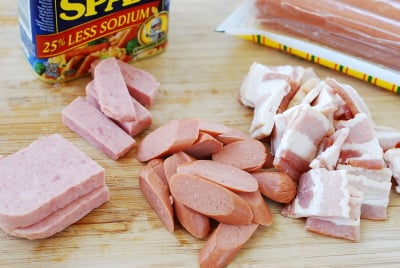



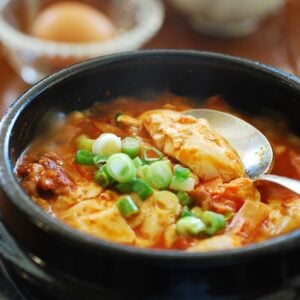

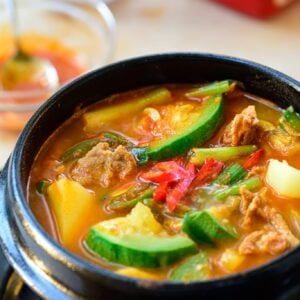













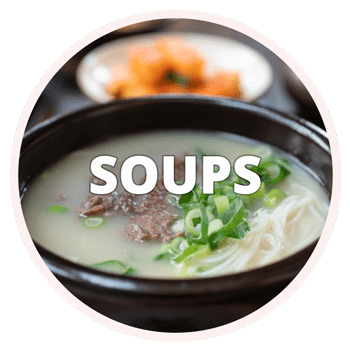
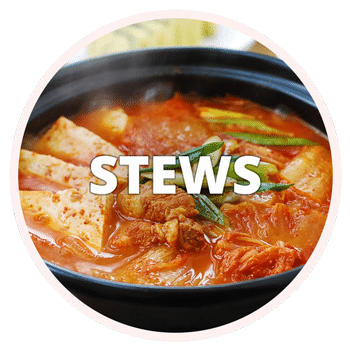


Cyrena says
Could I make this in a crock pot? I’m going away for college and wanted something savory and warm for the winter months.
Hyosun says
This doesn’t take long to cook once you put the pot together. While it could probably done in the crock pot, I’m afraid it might not give you the best results.
Kareen says
Tried this recipe over the weekend and it’s a hit for the family. The recipe is a keeper. Thank you.
Hyosun says
Awesome! Happy to hear that. Thank you so much for letting me know!
Sally says
I’m 14 and I find cooking pretty fun I really enjoy cooking Asian cuisine so I made this for dinner and it’s so good except I used rice and this is so good I recommend it a lot!
spicy lover says
How many calories in total…???
Hyosun says
hmmm sorry I don’t calculate calories for recipes.
Barb says
My son and I made this the other day on his suggestion. It’s wonderful.
Carol says
Hello! I have a question. Am I butchering the recipe and disrespecting Korean food culture if I make this without gochujang paste? I have bad acid reflux if I eat spicy food so I like to keep it on the mild side and I’ve not tried this recipe fot the longest time even though I really want to but I just know I won’t be able to handle the heat.
Hyosun says
No not at all. You can omit both gochugaru and gochujang. Actually gochugaru is what’s adding a lot of heat.
Rose says
I also can’t handle spicy food well, but I’ve found gochujang is actually not very spicy! I would recommend just buying a tub and adding liiiiitle by little. It’s mostly salty, not spicy. And really delicious! Even my dad who gets sick from spicy food can handle a little 🙂
Joyce says
Tried this today.. it’s superb delicious.! My 6yr old boy ate 2 small bowl noodles with a cup of water beside.. My family finished 5 packets of the noodles… All the ingredients and soup were go!
Valerie says
This recipe was nostalgic! After recently coming back to the U.S. after a brief 4 year stint in South Korea, I have missed Korean good like crazy. Luckily, this recipe was super easy with easy-to-find ingredients. I left the bell peppers out and replaced bacon with chunks of pork belly. Yum!
Hyosun says
So happy to hear you’re recreating Korean food you enjoyed in Korea! Budae jjigae is so versatile that you can use many diff meat and vegetables. Thank you so much for coming by to share your story and leave a great review for me. It means a lot to me!
laurine says
Made it last weekend and was surprised when i tasted it because the taste is very similar to my grandma’s choucroute – french traditional dish from the north east – but with a spicy kick. It was really unexpected but awesome to be reminded of those flavours
Annie A says
That’s very interesting. I had to google coucroute and found a recipe by Jacques Pépin on the Food & Wine website. Will try to make it! Thanks for the tip!
Hyosun says
Ha that’s interesting! Hope you enjoy it.
Shelly S. says
This was simply amazing and so simple to make. It was a beautiful dish for company and I loved that I could talk about the history behind the dish. Thank you for sharing this!
Victoria Lhan says
I love your website! My mother is Korean and she cooked Korean food for me everyday when I came home from school. I am now 26 and cannot depend on her anymore 🙁 even though I want to haha! Rather than calling her every two minutes I can look my recipes up on your site. Thank you for putting your receipes online for us to keep Korean culture going in our future generations as well!! My kids love Korean food!
Jennifer says
I just made this stew last night and it was a hit. My husband approved (he’s a chef). We were joking about maybe we should start selling this stew. LOL
Michelle says
I love your website! I find your recipes approachable yet elegant.
Michelle
Hyosun says
Thank you, Michelle!
Morgan says
Hello!
Just wanted to let you know that I loved the little history lesson on the recipe – its always interesting to learn and a great talking point when serving to guests! Very well written & I will definitely continue to check back for more interesting recipes.
Morgan
Susanne says
Dear Koreanbabsang, I notice that the Korean and North German Kitchen have a lot of things in common – Potatoes, fatty-salty, sweet- sour- anyway , since it seems to be a good year for zucchini in these parts i’m looking for pericies to preserve them this year and wonder if there’s a kimchi style thing you know of. thanks a lot, sann
Hyosun says
Hi Susanne – Koreans usually dry/dehydrate zucchinis to preserve and then rehydrate them when ready to use. We stir fry them to make side dishes or add to stews and soups. You can make kimchi with zucchini, although not common, but it will not keep long. Hope this helps.
Yongmin says
Hi, I find most gochugaru times not be spicy at all and I have to add a lot of it, which is a waste. Which brand do you find to be very spicy without having to add a lot? Thank you
Hyosun says
Hi Yongmin – It’s not really about brands. It’s the type of gochugaru. Some are labeled as “hot” 매운 고추가루. The ones made with cheongyang gochu 청양고추 are very hot. Hope this helps.
Lia says
Hi,
I love your blog, so many recipes my mum used to make, who now lives back in Korea and so I have to make them myself in the UK 🙂
Thanks for sharing these!
Btw, I think you have your advertising settings wrong because I’m getting adult ads on top of the page (very graphic).
Lia
Hyosun says
You’re welcome! I am happy to help you recreate your mom’s food. Oh goodness – thanks for letting me know. I will take care of it right away.
Helen says
Thank you for sharing the history behind this jjigae. My dad, child of the 50s, told us stories about this stew. I always think of him when I eat or make it. 🙂